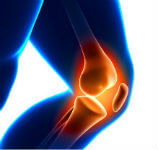Knee Bursitis Symptoms, Causes & Treatment

To understand what bursitis is, it is best to begin with a brief explanation of what a bursa is and what it’s role in the body is. A bursa is a fluid-filled sac that acts as a cushion between tendons, bones and soft tissue. Bursa are located throughout the body including the shoulder, hip, and knee. When the bursa to the joint gets injured and inflamed, this is known as bursitis. Knee bursitis is very painful and can limit activity and result in lifestyle limitations.
There are several bursae in the knee. The prepatellar bursa is located just in the front of the knee (Patellar) tendon is the most commonly injured bursa sac. Often times, remaining in a repeated kneeling position or an injury to the joint or can cause pain and swelling. When the bursa over the kneecap becomes inflamed it can be very painful. This can easily become inflamed, especially when you are in a kneeling position for a long period of time. The condition known as "housemaid's knee accurately describes the activity that causes knee bursitis. Depending on the severity of the bursitis, it can cause pain and swelling. It is common to hear patients report their knee feeling warm, swollen, red and tender with walking, climbing stairs, and pain when moving, and simply walking.
There are two other bursa in the knee that can cause problems for people. The second bursa, called the infrapatellar bursa, is located underneath the kneecap where the tendon attaches the quadriceps thigh muscles to the lower leg bone (tibia). Injuries to this bursa are caused by jumping activities and are referred to as “Jumper’s Knee.” The third bursa is called the pes anserine bursa and it is located on the inside aspect of the knee. Inflammation and swelling in this bursa is commonly seen in women/overweight individuals and can cause symptoms like pain in the back of the knee when climbing stairs and sitting down in chairs. This condition is called pes anserine bursitis.
CAUSES OF KNEE BURSITIS
Bursitis is caused by an injury to the front of the knee, but can also be caused by being a kneeling position for a very long period of time. Bursitis of the knee occurs when the bursa, which is a thin closed sac filled with fluid, becomes inflamed due to an injury to the knee or trauma.
SYMPTOMS OF KNEE BURSITIS
Pain caused by bursitis of the knee is usually not as severe as other types of knee pain like arthritis and meniscus tears, but it is debilitating especially for the individual that has to be in a kneeling position for a long time. This can cause pain, swelling, and stiffness during movement. Patients will have pain with flexing and extending their knee. Symptoms of septic bursitis can be similar, but patients may also experience fever in addition to having pain.
WHAT IS THE TREATMENT?
GENERAL
Generally, the treatment for knee bursitis will be the same for most types of knee bursitis. Treatment consists of rest, ice packs, compression, and anti-inflammatory medications. Occasionally a patient may require having a bursa drained in a doctor’s office. If the bursitis is septic, the patient may need to undergo a course of antibiotics to treat the infection and have the bursa drained more than once to remove all of the inflammation inside. Occasionally, patients will require drainage surgically and have the bursa removed.
INJECTION
If the bursitis is persistent and not responding to standard treatments, a doctor might inject a corticosteroid drug into an affected bursa to help reduce inflammation. The inflammation usually subsides quickly, but patients may have pain and swelling from the injection lasting for a couple of days
BRACING
Another way to alleviate pain is to wear a bursitis knee brace. A knee brace provides warmth and compression which can provide pain relief. It can also help offer stability for your knee
HOME REMEDY
Home remedies include R.I.C.E. Rest, ice, compression and elevation.
Knee bursitis is not the most painful knee condition but it does need to be treated so that it does not become worse especially as the individual gets older. If you think you might have knee bursitis, check with your doctor to make sure, and then find out which treatment method is best for you.
SUPPORT & PROTECTION FOR KNEE BURSITIS
DME-Direct carries a full selection of bursitis knee braces and supports that offer support and compression to help relieve symptoms. Click here to see all of our braces and supports for Knee Bursitis.